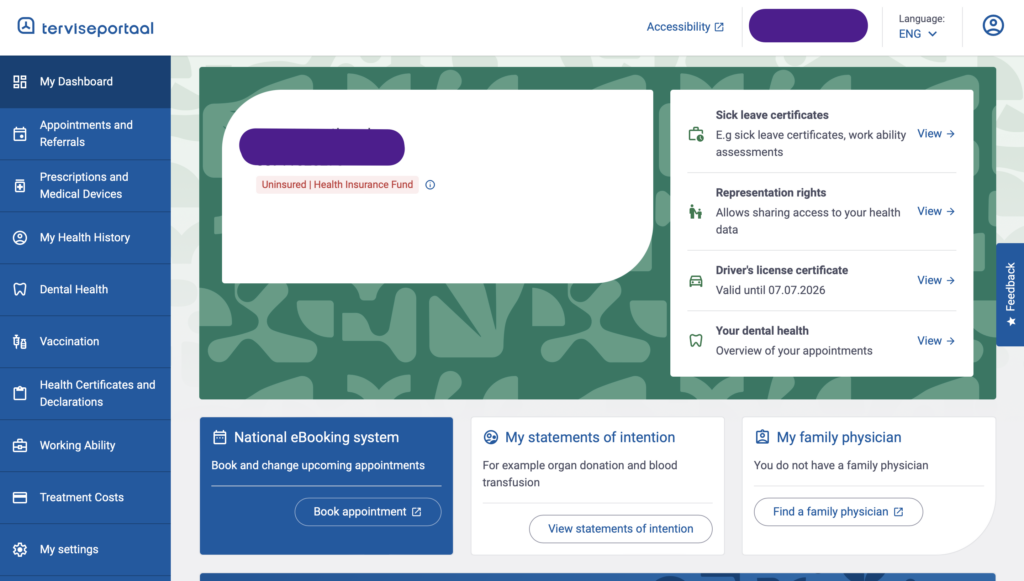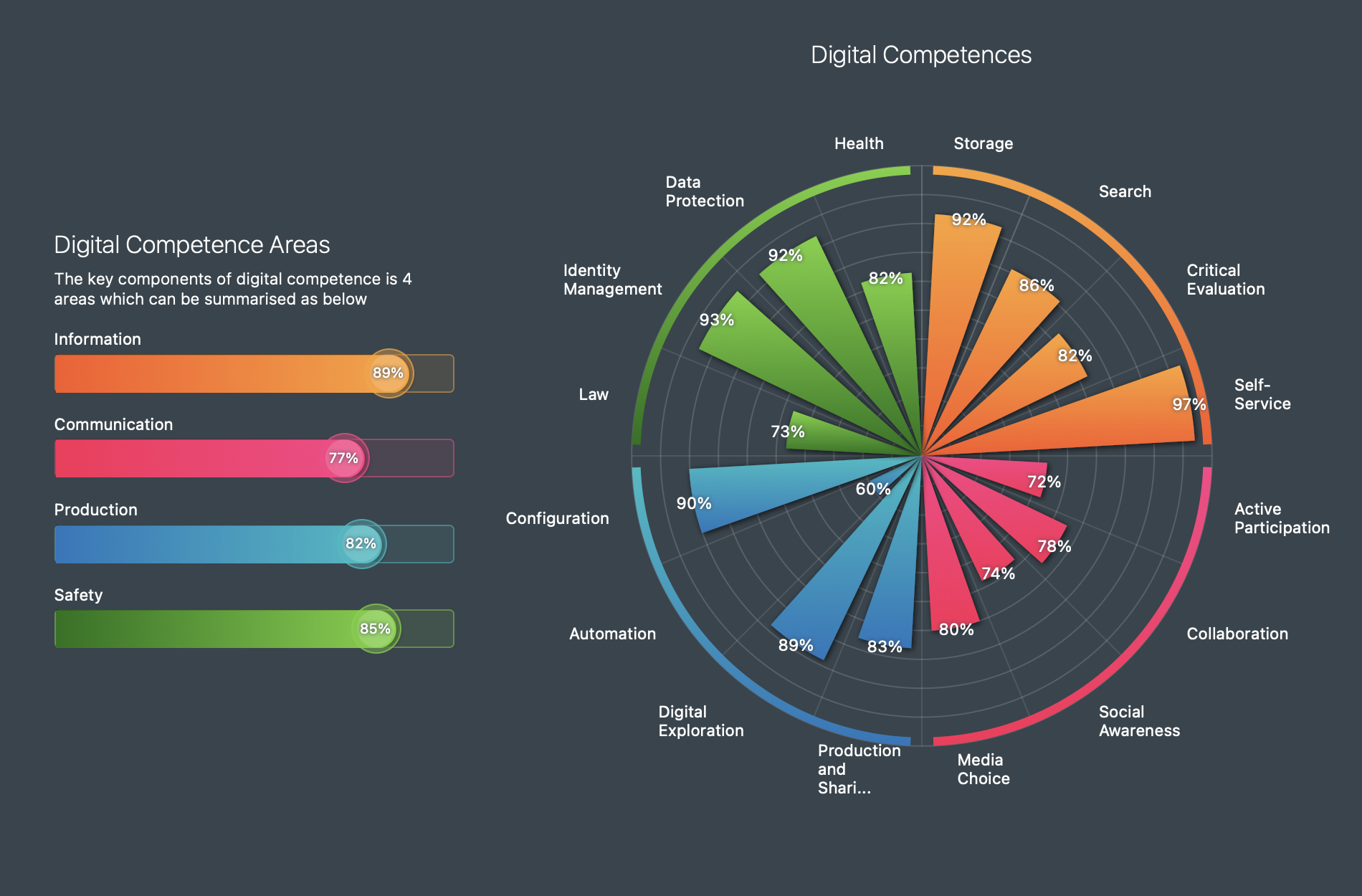Digi Citizen
For Finnish Students
- Familiarize with the Social Insurance Institution of Finland (KELA). What are the services you use personally and in your family? Get a European health care card.
As a European citizen who permanently moved to Finland, I became eligible for the Finnish social system and have my Kela card. - Access to your own health care data provided by OmaKanta. How did you access?
I am logging in with my S-Pankki online login. - Look how much pension you will get if you retire at 63 years, or 68 years (Keva).
It is currently inapplicable in my case, as I never earned anything significant in Finland. My sarcastic pension fund was withdrawn from Estonia as I emigrated.
For Foreign Students
Familiarize with the local social insurance system. What are the digital services you use? What are the development trends in that field (in your country)?
As I am from Estonia, any possible digital services are about a million miles ahead of any country. However, Finland is the closest one to the Estonian level of digitalization. Apparently, there are some problems with Estonian e-services. While the system is pretty good, some separate systems are outdated and require serious review, optimization updates, and upgrades. Unfortunately, the current situation is not favorable for the economy, and due to the stagnation of the financial situation and the decreasing economy in Estonia, there are not-so-fast innovational implementations. Estonia sat on a horse and ran fast, but some other countries, such as Finland, were calmly behind the tail. At the same time, with Finnish pedanticism and professionalism, systems might have fewer functions, and there might be more actions made on paper, but both systems still work flawlessly: on paper and online. Somehow, comfortable relief is understanding that even with all protective laws, the Estonian system is so transparent that Big Brother can know every step. In Finland, the state and people who serve it can get information about you, but that is more complicated. In Estonia, there are few clicks, and some specific people might learn anything about you, but still, not all people are perfect.
Describe digital services in field of social and healthcare in your country? What are the pros and cons?
The Estonian system looks similar to what I see in Finland. The previous version of “Digilugu” worked for about 15-20 years, and the first change for all of us was digital prescription, which was revolutionary in 2005. Corona put a high load on the system, and a severe update was required, and now it is ready. All hospitals and doctors can see your data if you do not block that feature or exact medical result. Ambulance fills your patient card with an iPad or a similar device, and you almost immediately can see your result online. I will demonstrate to you a screenshot from the personal cabinet of a new “Terviseportaal.” This time, Estonia luckily received a revolutionary feature, and that is a state-wide eBooking system. You can register visits for any doctor or nurse in the entire country, regardless of the location. That should liquidate long queues for specialists. Usually, you would wait 6-12 months to meet a specific specialist, but now I checked some random possible appointments, and waiting times are not more than 1 month, which is amazing. If you have your referral and state-provided insurance (you earn at least minimum wage, that is today (820€ brutto), you will pay the minimal fee of 5€, and if you don’t answer these criteria, you pay the full price (110€ indicated for several specialists), and every next step, the analysis will be paid, and prices about as in the Finnish and Estonia private medical institutions.

For All Students (Finnish and Foreigners)
- Visit e.g. digital shops like eBay, Amazon, Booking.com, Trivago and evaluate the prizes to local shop prices, and information adequacy to the consumer. Is the chosen service reliable?
So, eBay apparently became a website of the past for me, as that was actually in 2010 and is almost useless today. But there are other alternatives, including crazy Chinese competitors like AliBaba, AliExpress, Temu, and others. With enormous damping, and in the case of Temu, also with an outstanding speed of processing and shipping (from China to Finland 5-10 days), they completely paralyze us. Returns are possible, but of course, with warranty and later returns, you can’t have too much hope. For that, I will always come with European shops, or even with Finnish, to have more control over the situation. Of course, I like to keep more money in Finland, even if this money is not mine anymore. Some giants, such as Amazon, are still somewhere in the UK that is not anymore EU, and in Germany, that is still far away. With the latest changes in the logistics due to Corona and war, delivery costs might kill the entire reasonability of any purchase. After all, I am not a shopaholic, and this is not so important for me. For my hobbies, I know the exact suppliers, order through an EU-registered company, keep it as a business cost, and save on intra-EU VAT. 🙂 - Find one service/application from your own field. Explain reasons for your choice and your user experiences.
As I mentioned above, I have some hobbies. One of them is knifemaking; for that, you must learn metals, wood (and similar materials for handles), and of course, leather, Kydex, etc., for the sheats. If I had sourced only locally, I would have enormous losses, and the building price of any kind would be gigantic. If you wish to make one knife, this is fine, but I currently have materials for about 30-40 puukkos. (I wish I had the time and power to make them all right now.) With online purchases and using my Estonian company, I save about 30% of source materials compared to the local market. Of course, you can get anything you wish from the entire world: cheaper and more expensive. There are some tools for leather that cost 1€, and they work perfectly. However, my extremely fine brass stamp, “Made in Finland,” produced by a CNC master in Bulgaria, was purchased online and has outstanding premium quality. Without the Internet, I would never have built a knife with a 5000-year-old handle, and the cost of it wasn’t even so high; materials without my personal work were just 50€. - Digitalization and digital gap; what are the risks and challenges for those people, who do not use virtual services?
For those not using virtual services, digitalization has presented serious hazards and challenges. Economically, people without digital access lose out on e-commerce advantages and employment possibilities, which results in more unemployment and challenges competing with online stores. Students without internet connection find it difficult to access instructional resources and acquire digital skills, therefore extending the educational gap. In healthcare, people without internet access cannot gain from telemedicine and online health management, so producing worse health results. Socially, without digital access, one misses out on community involvement and support and becomes isolated. Civic involvement is also affected when access to government information and services moves more and more to digital. Those without internet connection participate in democratic processes less informedly. Dealing with the digital gap calls for increasing internet access, providing digital literacy programs, funding equipment for low-income homes, and creating inclusive digital services to guarantee that no one is left behind. Bridge this divide and minimize the negative consequences of digital exclusion via coordinated initiatives across governments, businesses, educational institutions, and community organizations. - You can find a list of bookmarks on the right bar. Read what other students have written about this topic.
Done. - Leave a comment on three interesting articles. Remember to include the URL of your blog, so that person can visit you as well. Please note that your comment is awaiting moderation and it will appear after it’s approved. It is faster and easier to write comments, when you have logged in to the wordpress.com.
I commented on page here: link with text “Thank you, Johanna, for providing insights into your encounters with digital services in Finland. The efficiency of institutions such as Kela and platforms like OmaKanta in facilitating access to crucial information and services is remarkable. I like your perspective regarding the ecological ramifications of quick fashion and the moral implications of online shopping. Your thoughts on the digital competence test and its focus on ongoing learning connect with many of us navigating the digital realm. Continue to investigate and communicate your experiences!”
My second page I have chosen was here. My answer is: “Johanna, your blog is a great tool for recognizing the impact of digital transformation on our society. I find your analysis of how digital platforms enhance both personal and professional aspects to be really illuminating. Your approach to discussing digital competencies and emphasizing the significance of keeping up with technological changes is both pragmatic and motivational. I eagerly look forward to delving deeper into your insights and reflections on maneuvering in the digital realm. Continue the fantastic effort.”
And third page here, and my answer: “Dear Eeva-Maija, Your self-evaluation of digital competencies is perceptive. Your ability to acknowledge your strengths and places for progress, especially in communication, is praiseworthy. You must comprehend the concept of the digital divide and recognize the significance of inclusive digital solutions. Highlighting the importance of maintaining good health and well-being in the face of growing screen usage is a valuable reminder for everyone. Continue to engage in exceptional introspection and ongoing acquisition of knowledge!” - Do the Digital Competence Test here. (If you want to show your skills – go to Open Badges to get certificates)
I’d say it is more of a self-evaluation tool than an actual competence test. Anyone can answer anything or answer very subjectively. However, it is a fine tool if you want self-assessment and is more or less grounded and realistic.

- Finally, write three ‘pages’ about your thoughts and experiences into your blog. Remember to write a brief self-reflection, too. What did you learn from these assignments?